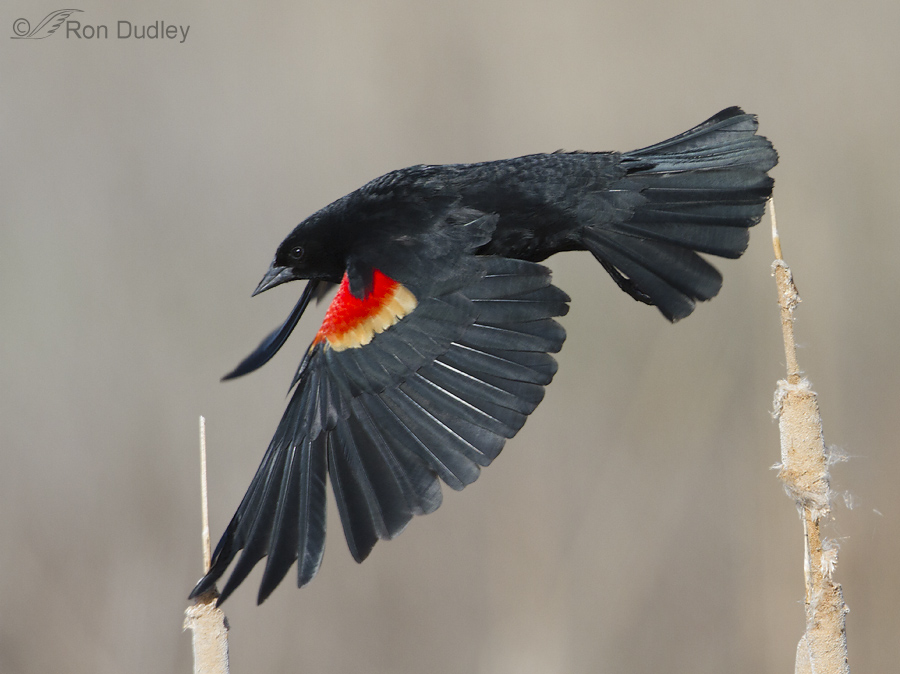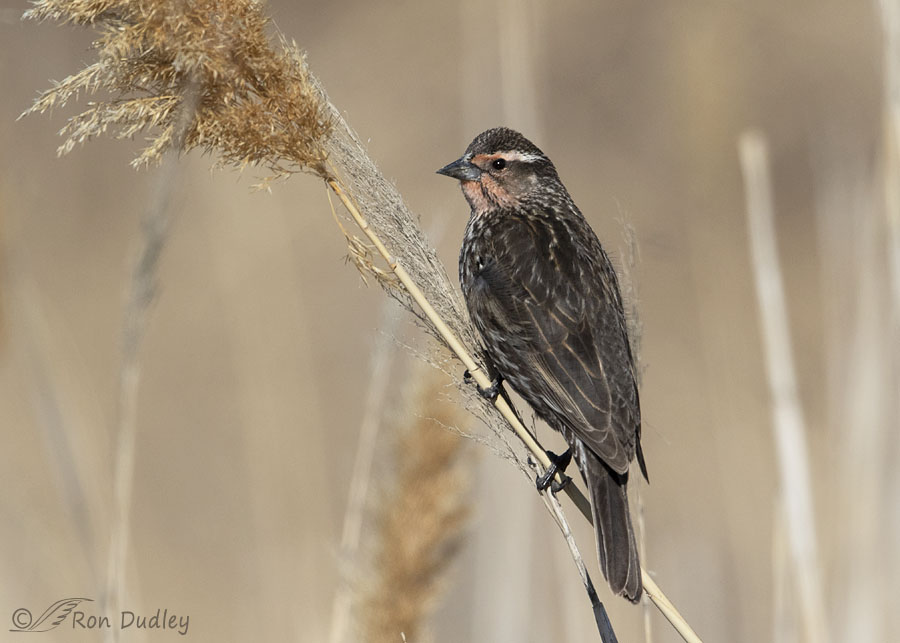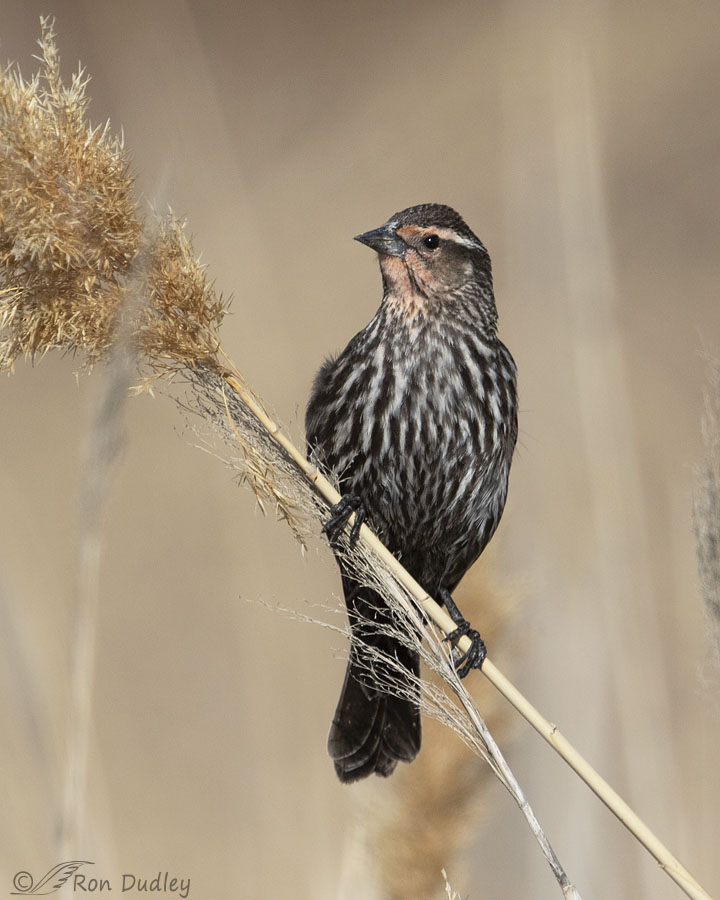Lots of folks don’t.

1/2500, f/6.3, ISO 500. Canon 7D, Canon EF 500mm f/4L IS II USM + EF 1.4 III Extender, not baited, set up or called in
Red-winged Blackbirds are one of the most abundant bird species in North America and the distinctive males with their glossy black overall plumage and red and yellow wing epaulets are one of the most easily recognized of all of our birds. Most casual observers almost instinctively recognize the males as ‘blackbirds’ of some kind and those red epaulets are such a flashy field mark that narrowing them down to Red-winged Blackbirds is typically an easy task.
But females are another story.

1/6400, f/6.3, ISO 500, Canon 7D Mark II, Canon EF 500mm f/4L IS II USM + EF 1.4 III Extender, not baited, set up or called in
Female Red-winged Blackbirds are 50% smaller than males (by weight) and their definitive plumage is far less conspicuous, as illustrated by this female I photographed at Bear River MBR three days ago. Even their behavior is much less conspicuous so they’re less often noticed than males.
Adult females are mottled brown on their dorsal surfaces with a prominent pale eyebrow stripe and a pink to buffy throat.

1/6400, f/6.3, ISO 500, Canon 7D Mark II, Canon EF 500mm f/4L IS II USM + EF 1.4 III Extender, not baited, set up or called in
Females have heavily streaked breasts and bellies as illustrated when ‘my’ bird turned on her perch. The legs and feet of adult males are black but in females they’re dark brown or dusky, often appearing ‘blackish’. Males have black bills while the bills of females (and juveniles) tend to be dark brown above and brown to light brown below, with some variation. Juveniles of both sexes resemble females, but are duller.
In my experience there’s another reason why so many folks don’t recognize (or misidentify) female Red-winged Blackbirds. During the breeding season males are highly conspicuous during their incessant, rowdy and noisy displays in the marsh atop elevated perches but females tend to be more skulky, spending much of their time hiding in the reeds. So we tend to see, or at least notice, far more males than we do females.
OK, enough of the ID lesson. But it’s ‘blackbird season’ so I thought a primer on their identification might be useful to some blog followers.
Ron


This is excellent – a lesson I am constantly teaching to older folks who aren’t birders! Many thanks.
P.S. And their song can be gloriously deafening!
I grew up in the marshes of WI, so the Redwing was the primary bird in the spring and the fall. I must get around to see them; haven’t seen one yet in the Hill Country around Austin!
Thanks for all the great photos!
Thank you for the beautiful photos, and information. It’s like having extra eyes, and it’s encouraging, too. The birds are still out there. K
There’s a heavily human used lake near me where the grass is mown up until the cattails abruptly rise. Perhaps because humans are so commonly around the area, the females go about their business without notice if one stands quietly (in my case, next to my tripod and camera) for a few minutes. When standing near the cattails in a spot where many are broken or not tall, it’s possible to observe the females building and repairing nests, foraging, etc., sometimes so close I could almost reach out and touch them.
I have been wondering where the Red-winged Blackbirds are that come to the feeders every year. Got a double dose today, first with your post and then both sexes arriving at the feeder. I feel fairly confident ID’ing the female in the field (habitat certainly helps!), although they don’t seem to have the reddish tint on lores and throat that I see in your photos.
Lyle, from my research and my field observations I think those reddish colors you mention may be highly variable. We saw another female that same morning where they weren’t nearly so prominent.
Thank you for posting this. You are absolutely right. I didn’t know! I see redwings often on the Sacramento-San Joaquin Delta…now I will try to spot females. I value your posts, especially because I’m new to birding.
Your comment is appreciated, Phoebe. It reinforces my belief that there’s a lot of folks out there who don’t recognize the females so it suggests that my blog post is having it’s intended effect. Thank you.
Thank you. Even from this side of the world I could (and do) recognise and identify the male. The female I would have had to chalk up as a fail.
I’m curious, EC. Do have any species of blackbirds (not black birds) in Oz?
The Common Blackbird was introduced to Australia at Melbourne in the 1850s. The male is the ‘black’ bird, with deep orange to yellow bill, a narrow yellow eye-ring and dark legs. The female is a brown bird, with some streaks or mottling, and has a dark bill and legs. Immature birds are similar to the female with lighter underparts. Introduced, and like many ‘alien’ species doing very well here.
Thanks for the info, EC. Yes, your country (continent) has more than its fair share of introduced species, of all manner of vertebrates.
Sadly we do. And of course I include our species. We like other introduce species have largely displaced the our first people and certainly impacted on their habitat and their lives in a destructive way.
Sexual dimorphism at its finest! I see the occasional male, but now I’ll definitely be on the lookout for the females.
Hope you spot some, Marty.
I have also noticed during breading season the males stay in groups on top of singing platforms and the females stay in big flocks of just females. Same with the Yellow-headed blackbirds.
Beautiful photos, Ron.
Interesting observations, April. Thanks.
Haha, the very bird that had me in a fever in February! She was on a seed cylinder feeder, a bird I had never seen here before and I was convinced she must be a rarity (I’d just had Green-tailed Towhee and Black-throated Gray Warbler visits a few weeks earlier, so…). I emailed pics to my local birding friend, who shocked me with the news this is female RWB! In my defense, I’ve never even seen a male RWB in my neighborhood before …
Sounds like they’re an unusual species for your area, Chris. Good for you for following through and getting a reliable ID.
I used to write a column for our local newspaper (before it was taken over by a national conglomerate and … that’s another story). One time I wrote about Red-winged Blackbirds and included two photos – a male and a female. I included a detailed description and pointed out how many people think of sparrows when they see them. I detailed some of the differences between female Red-wings and sparrows commonly seen in marshy areas. The caption under the female’s photo said “Female Red-winged Blackbirds are often confused with sparrows.” A reader wrote back to inform me that my photo was wrong because I had shown a sparrow. She told me that all “Red-winged Blackbirds have red wings. It says so in their name.”.I did get many comments thanking me for teaching them something new even if one person still thinks I’m wrong. Another time, while out birding, someone asked if I knew what that bird (female Red-wing) was. I told him. He said “Oh no, I’m sure that’s not right. We need to ask that guy who writes for the paper.” Keeps life interesting
Dan, incidents similar to those you mention are exactly the reason I decided to publish this post – that and the fact that I had photographed this female only a few days ago.
I hope that guy who wanted to ask “that guy who writes for the paper” knew at some point that he had egg on his face.
Outstanding photos Ron. I laughed as I read the question. The answer is yes, but it took a couple years before I was confident that I had it right. One of our local bird experts has been very patient with me over the years as I went from knowing nothing about birds to being fairly proficient at identification. A couple times during the learning process I misidentified the female Red-wings and he would mildly chastise me and remind me that I should have known that. As of now I would consider myself an expert female Red-wing identifier.
We have flocks of them here year round. During most of the winter they separate and we see large groups of females together. Then of course when spring mating times come they are back together and nesting and reproducing in the marshy areas around all our lakes.
Everett, folks like your friend who are generous with their knowledge and eager to be helpful are invaluable at assisting the rest of us in identifying birds. I’ve had a few friends like that over the years myself.
Beautiful shots, Ron….
Thanks, Judy. Years ago it took me a while to figure the females out too.
All three photos are terrific! I’d prefer not to have so many of the males showing up at the feeders. True…a lot of people confuse the female of the species. Personally I think she is quite an attractive bird. In all my years of feeding birds, I have never had a female come in to my feeders…and I live in the country with wetlands very nearby. As you put it…they are skulkers! I seem to catch them either very early a.m. or twilight when they tend to emerge to feed.
Kathy, I rarely see females at my feeder. And I agree, females are quite attractive in a far more subtle sort of way..
Thank you, for this information. I think and probably have identified the female as a House finch or a Cassins. I am learning to identify birds. A novice.
Take Care,
Kaye
Kaye, I’ve found that learning to ID birds is always a work in progress. It doesn’t come easily for me.
It was helpful to me, for sure. I often see the males in a local marsh, but I think I’ve been confusing the females of assorted Grackel or Cowbird species with those of the Red-Winged Blackbird. I’ll start looking more closely in the thick reeds surrounding the ponds where the males like to sit and sing.
“It was helpful to me, for sure”
Good! Thank you, Shoreacres.